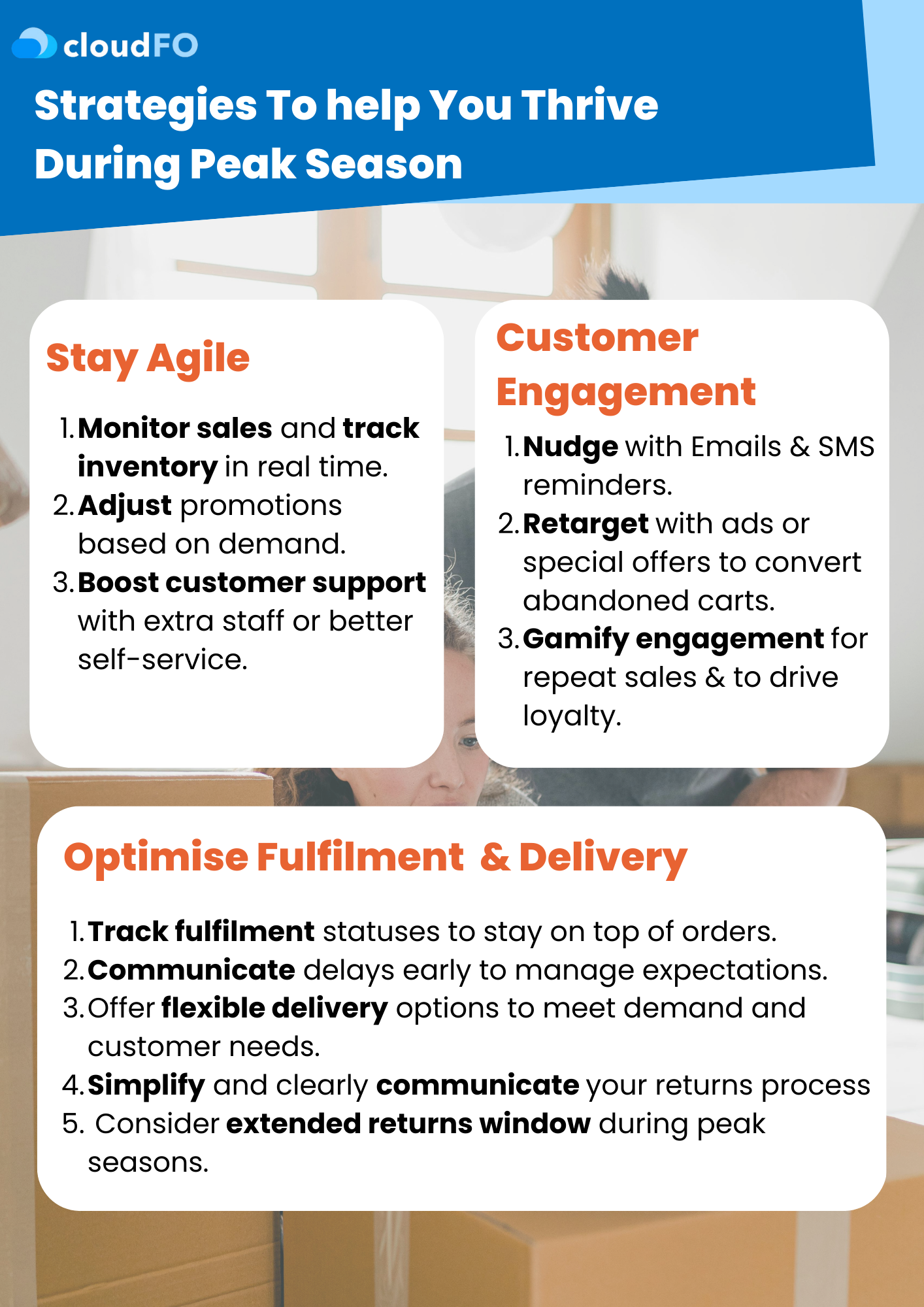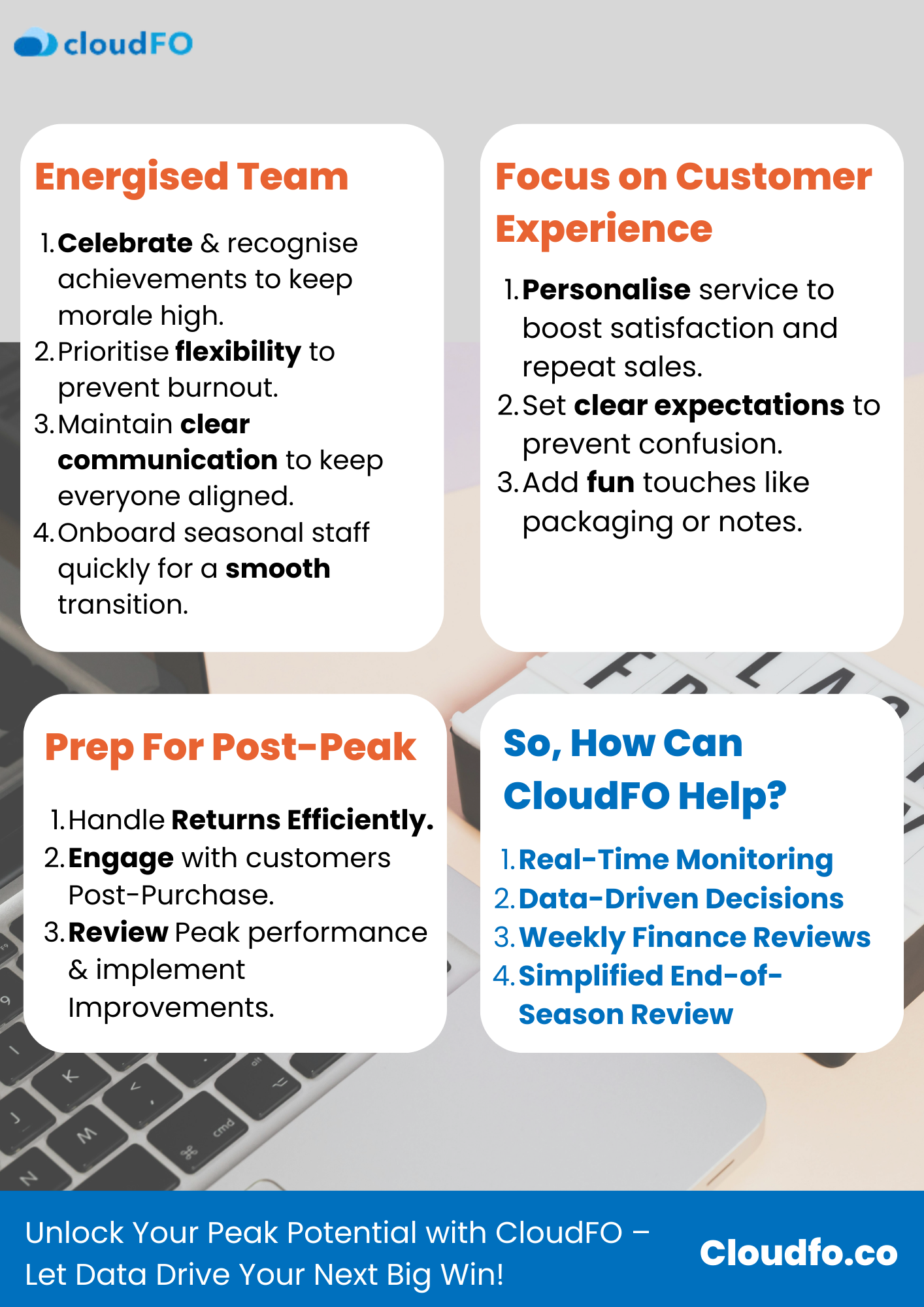Thriving During Peak Season: Strategies to Stay on Top During Key Dates

You’ve spent the last few weeks or months preparing for peak season—whether it's Black Friday, Cyber Monday, Christmas, or other key dates. Now that it’s here, how do you ensure everything runs smoothly? Let’s cover practical strategies for staying agile, responsive, and successful during the most intense trading periods of the year.
Stay Agile: Adjust and Adapt in Real-Time
Even with meticulous planning, the reality of peak season can still present unexpected challenges. This is where agility is crucial:
- Keep a Close Eye: Monitor Sales and Stock Levels Daily
During peak season, sales trends can shift quickly. A product you thought would sell slowly could suddenly become a top-seller. Use real-time inventory tracking to keep a close eye on stock levels. If a popular product is selling out fast, consider ordering more (if feasible) or redirecting marketing efforts toward other items. Real-time tracking enables you to replenish fast-moving items and capitalise on demand to maximise sales and avoid stockouts, which can lead to lost revenue.
- Be Flexible with Your Promotions
Based on customer behaviour, continuously review and, if needed, adjust your promotions. Flash sales or "last-chance" deals can help you clear remaining stock or re-engage customers who haven't made a purchase yet. For instance, if certain items are not moving as expected, a flash sale with limited-time offers could create urgency and drive sales. This can free up cash trapped in unsold stock and improve your cash flow during the critical period.
- Adjust Customer Support Resources
During peak season, expect an influx of customer enquiries, from delivery tracking to product questions. If you notice a rise in customer service queries, consider adding extra support—whether that’s extending hours for your team, hiring additional temporary staff, or improving self-service options such as FAQs and chatbots to reduce pressure. Effective customer service management prevents potential lost sales due to unresolved issues and helps retain customer loyalty, which translates to future revenue.
Optimise Fulfilment and Delivery
Managing fulfilment and logistics efficiently during peak season can make or break your business. Delays, missed shipments, or issues with tracking can severely impact customer satisfaction.
- Stay on Top of Fulfilment Performance
Ensure you communicate and manage your shipping cut-offs clearly. Keep an eye on your logistics and delivery partners, ensuring they’re sticking to promised timelines. If there are any delays, communicate early with customers to manage expectations. Clear communication reduces the risk of refunds and lost sales due to missed delivery deadlines, protecting your revenue during a hectic period for all parties.
- Consider Expanding Delivery Options
Offering a variety of shipping options can help ease the pressure on your logistics while giving customers more flexibility. Not every customer needs their goods delivered immediately—some may be willing to wait a bit if it means saving on delivery costs. By providing choices like economy shipping, express shipping, or even scheduled delivery, you can cater to different customer needs and budgets while managing your shipping resources more efficiently. This also helps to spread out order fulfilment over time. Some businesses choose to temporarily suspend express shipping methods during peak periods to better manage capacity and avoid bottlenecks. Effectively managing this not only improves customer satisfaction but can also save you costs on premium shipping services, helping maintain profit margins.
- Manage Returns Strategically
While a surge in sales is great, the reality of post-holiday returns can be challenging. Make sure your return process is as seamless as possible. Consider extending return windows, which is particularly appealing during the gift-giving season, as it provides customers with added peace of mind. Many buyers base their purchasing decisions on the flexibility of your return policy, so being generous here can enhance customer satisfaction and loyalty. A smooth returns process minimises the risk of lost customers and enhances retention, ultimately boosting future sales and revenue.
Keep Customers Engaged During the Season
Staying engaged with your customers throughout peak season helps you maintain momentum:
- Nudge Them Back: Targeted Emails & SMS Updates
Automated emails or SMS can help recover abandoned carts and drive repeat purchases. Follow-up offers or reminders about best-sellers keep customers engaged. These timely communications can convert potential sales into completed transactions, reducing cart abandonment and boosting overall revenue.
- Reconnect with Retargeting Ads
Retargeting ads on social media and search engines can bring back visitors who didn't convert initially. Customising ads with special offers can encourage them to complete their purchases. This could maximise the return on your ad spend and increase conversion rates, driving additional revenue from previously lost opportunities.
- It’s Game On: Gamify Engagement for Repeat Sales
Introducing gamification—like offering double loyalty points for holiday purchases or referral bonuses—can incentivise repeat sales. This not only enhances customer engagement but also encourages higher purchase frequency, resulting in increased lifetime value and greater profitability during peak season.
Keep Your Team Energised and Motivated
It’s not just your customers who will be feeling the peak season frenzy—your team will too; it can be a really stressful period.
- Celebrate Wins in Real-Time
Peak season is tough, so make sure you’re celebrating small wins with your team to keep morale high. Whether it's hitting a sales goal or achieving fast delivery times, small rewards or recognition can go a long way in keeping your staff motivated.
- Don’t Forget Flexibility and Wellness
If possible, stagger shifts to prevent burnout. Also, provide flexibility where you can—allowing your team to take breaks or swap shifts if necessary to maintain energy levels. For remote teams, ensure you’re using communication tools to stay connected and support each other in real time. This flexibility helps maintain high performance and reduces turnover, saving costs associated with hiring and training new staff during this critical period.
- Clear Communication is Key
During peak season, communication can become disjointed with increased workloads and stress. Make sure there are regular check-ins, briefings, and updates so that all teams—from customer service to fulfilment—are aligned and informed. This helps to minimise errors and improves efficiency, directly impacting customer satisfaction and sales performance during this busy time.
- Onboard Seasonal Staff Like a Pro
Ensure that seasonal staff are onboarded quickly and efficiently, providing them with the necessary training and resources to contribute effectively from day one. Clear guidelines and support will enable them to integrate smoothly into your existing teams, helping to alleviate the workload during peak periods.
Focus on Customer Experience
Despite the rush, it’s essential to keep your customers at the heart of your operations. A positive experience during peak season can turn a first-time buyer into a loyal customer.
- Serve Up Personalised Customer Service
Ensure your customer service team is equipped with the right tools to provide personalised responses to enquiries. Whether it’s tracking orders, answering product questions, or managing returns, delivering exceptional service during peak times can distinguish you from competitors. This level of service not only enhances customer satisfaction but also increases the likelihood of repeat purchases, ultimately driving long-term revenue growth.
- Set Clear Expectations Right from the Start
Customers understand that delays can happen during peak periods, but they will appreciate businesses that are transparent about shipping times, stock levels, and return policies. Make sure these details are prominently displayed on your website and in confirmation emails to set the right expectations from the start. Clearly communicating any changes from your usual business practices helps prevent misunderstandings that can lead to refunds or lost sales, protecting your revenue during this critical period.
- Go the Extra Mile with Fun Packaging and Presentation: ’Tis the Season
Little details like personalised thank-you notes, gift wrapping, or holiday-themed packaging can make a lasting impression. These small touches can significantly elevate the overall experience and make customers feel valued. However, it's essential to manage any increase in costs and understand the potential impact on profit margins to ensure that these enhancements are sustainable for your business.
Prepare for the Post-Peak Period
Lastly, remember that peak season doesn’t end once the rush is over—how you handle the post-holiday period is just as important.
- Tackle Returns and Exchanges Head-On
Once the holidays are over, you’ll likely experience an increase in returns. As stated above, make sure your returns process is seamless and easy to navigate. You also need to consider your operational strategy for handling returns—specifically, to evaluate whether returned items can be efficiently processed and resold. Managing this efficiently can help minimise losses and improve your bottom line.
- Keep the Connection Alive with Post-Purchase Offers
Once a customer has made a purchase, keep the relationship going. Consider sending post-purchase follow-up emails with product care tips, accessory suggestions, or loyalty offers to encourage future purchases.
- Dive Deep into Peak Performance Analysis
After the peak season ends, take time to review your performance. What worked? What didn’t? What could be improved? Collect feedback from customers and team members, review your campaign performance, and you can use CloudFO to analyse your sales and financial performance data. Use these insights to refine your strategy for the next peak period.
How Can CloudFO Help?
- Real-Time Monitoring: Gain insights into key metrics related to income, expenses, sales, and returns in real time, enabling you to make informed decisions quickly.
- Informed Decision-Making: Run detailed analyses as you adjust your strategies throughout the season, allowing for data-driven choices that align with your goals.
- Weekly Finance Reviews: Utilise weekly finance reviews to stay on track and set achievable goals for the week ahead, ensuring you’re well-prepared for the challenges of peak season.
- End-of-Season Review Simplified: Streamline your end-of-season review process, making it easier to assess performance and identify areas for improvement.
Let your AI finance colleague alleviate some of the stress during this busy period by providing insights and recommendations tailored to your business needs.
In Conclusion
Peak season is fast-paced, but with the right strategy in place, you can navigate through the challenges and capitalise on the opportunities. By staying agile, keeping your customers engaged, supporting your team, and focusing on delivering a great customer experience, you’ll be well-positioned not only to survive but to thrive during Black Friday, Cyber Monday, and the entire holiday rush.
Here’s a summary of the article below, presented in a two-page, easy-to-understand infographic:






